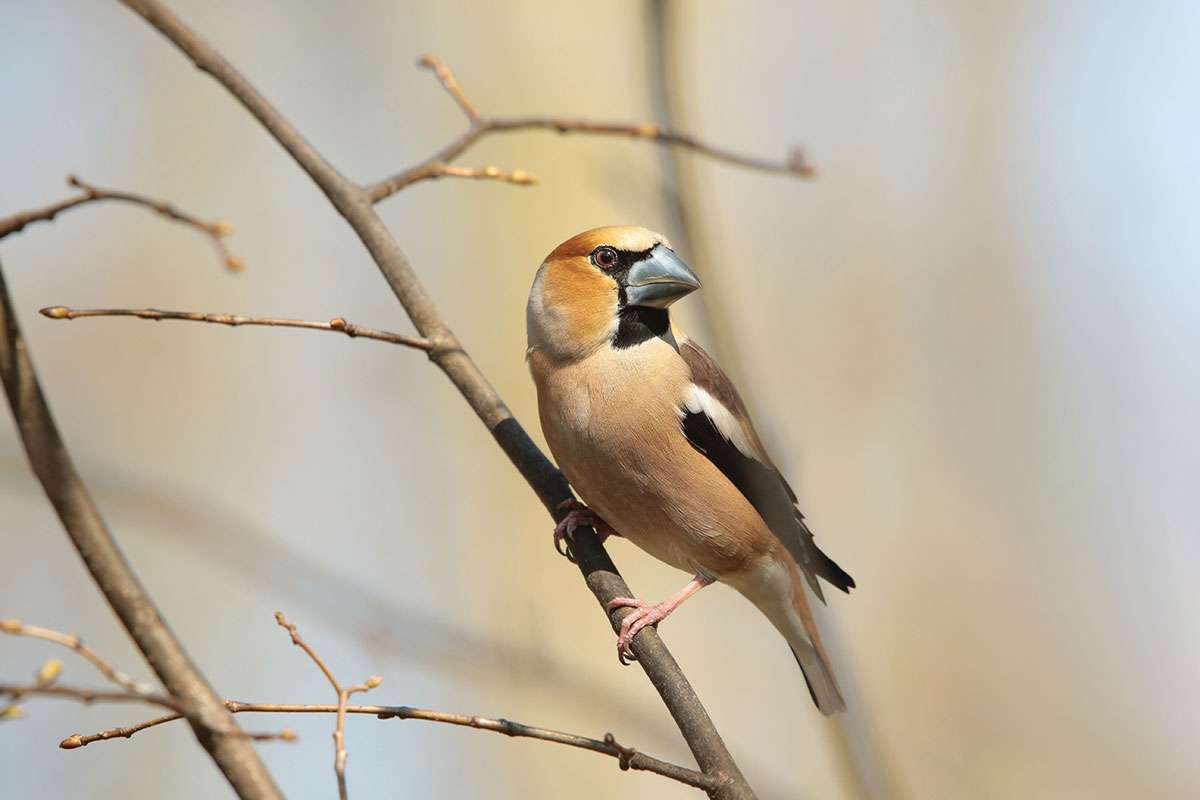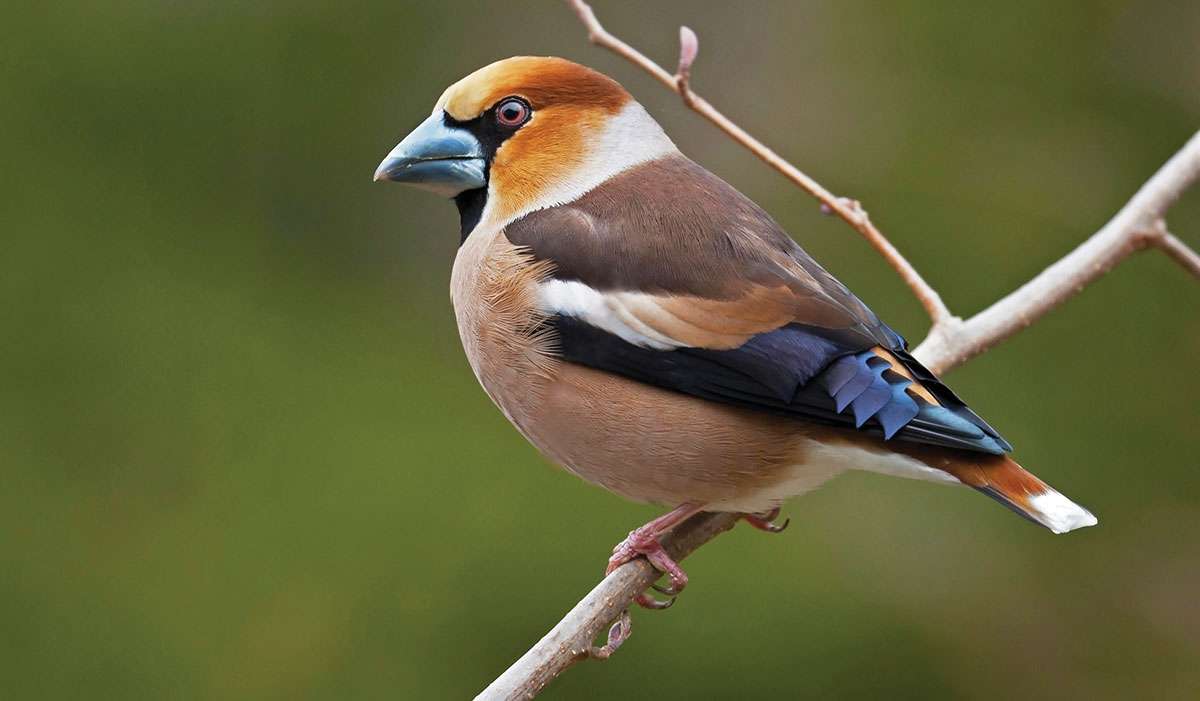
Hawfinch (male) Coccothraustes coccothraustes
Cheers to the New Year! Over Christmas I’ve enjoyed the fruits of last Autumn’s labours in one of the prickly mini forests bordering Cranleigh’s country footpaths.
Picking the shiny ripe bluish-black berries from the blackthorn bushes doesn’t come without a cost (ouch!). But a season later there were warming sweet rewards to be shared and enjoyed with friends as we toasted the highlights of the birding year just gone and bid welcome to what the skies might bring us in 2018.
This year our sloe gin tipple – a tasty delight to fight the winter chill – had an added dimension because it represented a double celebration. Without those sloes, and wading through the mud to get them, I’d have missed out on finding my first local sighting of an extremely scarce village visitor.
From early last October it became clear that something extraordinary was happening. Surrey birders started seeing some strange-looking birds flying overhead. At first there were just sightings of singles. But soon there were more. Some were seen feeding in woodland and soon flocks totalling double figures were being sighted.
Hawfinches! One of Britain’s most scarce and secretive species was spilling over in hordes from continental Europe. Presumably its food stocks, such as the beech mast crop, had failed in the face of a harsh winter. Or perhaps it had a bumper breeding season.
The orangey-brown Hawfinch is a comical looking bird and quite unlike any other we see in England. Its facial expression reminds me of a sad clown and its grey neck band looks a bit like a scarf wrapped above the brown coat of its back. It has broad white wing bars and a large white band across the tip of its stumpy tail. In summer it has a glossy blue edge to its inner wings.

Hawfinch (male) Coccothraustes coccothraustes
This winter’s Hawfinch phenomenon wasn’t just happening in Surrey. Similar reports were coming from all over the country. And the invasion was also being experienced in southern European countries too.
I’d occasionally seen Hawfinch flying over Leith Hill Tower but despite years of hoping had never found one in the immediate Cranleigh area. In fact, I was only aware of nine historical confirmed records around the village and finding one was not helped by the apparent lack of Hornbeams in the vicinity, the bird’s favourite tree.
But now, surely this was my big chance. I searched the skies daily to no avail. I wandered the Surrey Hills open spaces, hoping to hear or see one heading past alongside the small flocks of migrating Redwing. Nothing. I scanned all the likely tree tops, but to no avail.
Days passed and the pressure grew as various birding buddies all added their contributions to the mounting tally of unprecedented Hawfinch sightings. We were surrounded! Every day there were more. People were seeing them in Capel, Clandon, Dorking, Shalford, Thorncombe Street, and Winkworth. Everywhere, it seemed, but Cranleigh!
I felt I just wasn’t at the party and feared the influx would cease without me ever taking up this big chance. Oh, what shame that would be. After nine days, with still no Hawfinch flyovers here and some friends only a few miles away experiencing multiple sightings, I decided to go and pick sloes. Who knows, I thought, I might just be in luck…and find a Hawfinch too.
Portly Hawfinches are the finch family’s tough guys. They can weigh more than twice as much as a Chaffinch and have an oversized head and no-nonsense conical bill made for cracking cherry kernels . . . and sloe stones. Maybe the blackthorn area I had in mind would have attracted down a passing Hawfinch and do the business for me. Optimism is an essential part of the birder’s kit.

Hawfinch (female) Coccothraustes coccothraustes
I picked a few sloes and moved on to another patch. As I briefly stood and looked for more fruits, guess what? Suddenly up popped two birds from inside one of the bushes only about 25 metres away. The light conditions were not great and I was annoyingly unable to get much colour detail on them.
What I did see with the naked eye and through binoculars was a small thick neck, a proportionately big head with huge bill, short stubby tail, wide blunt wings and rounded bellies, no doubt full of berries. Hawfinch! They quickly rose silently into the air and flew off over the bushes and were lost to view in seconds. Gone in a tick.
I stood in shock. At last, after 35 years of trying, these were my first Cranleigh Hawfinches. But it got better. In the Surrey Hills a week later, a friend and I saw a total of 10 birds emerging from the east one foggy dawn.
After two weeks on full alert I finally had one flying over the garden, followed by three more, heading south west. Then on the Surrey Hills at Headley Heath near Box Hill one afternoon things really took off. I saw 79 birds. That’s more than are sometimes found over many years in Surrey. There may well have been much more in the vicinity too. Many of these were perched on the treetops giving excellent views. With the leaves now off the trees the Hawfinch should be much easier to see so I’m hoping for a few more local ones before they head off back home to Russia or wherever.
We can only hope a few of them decide to make their winter holidays permanent.











